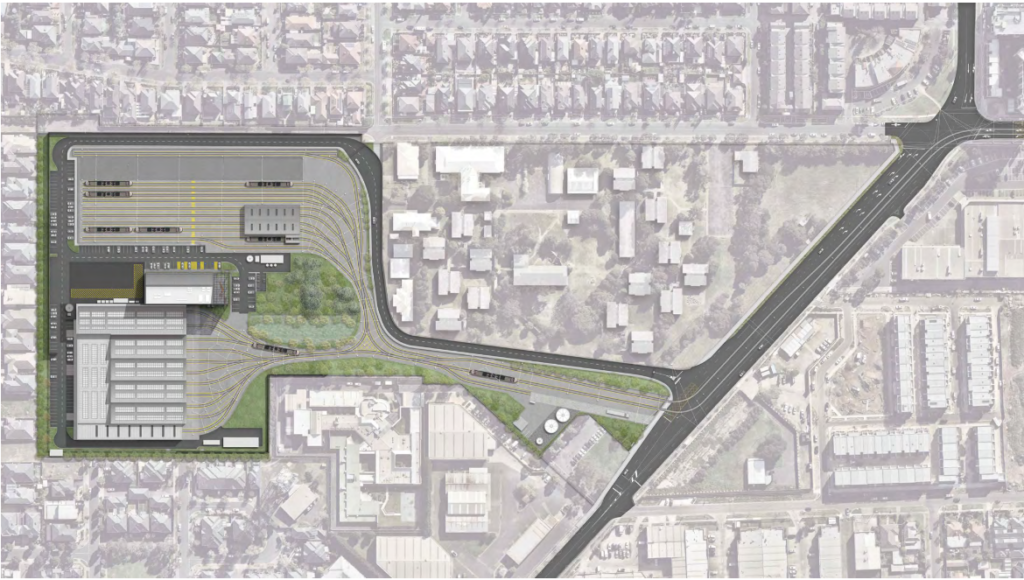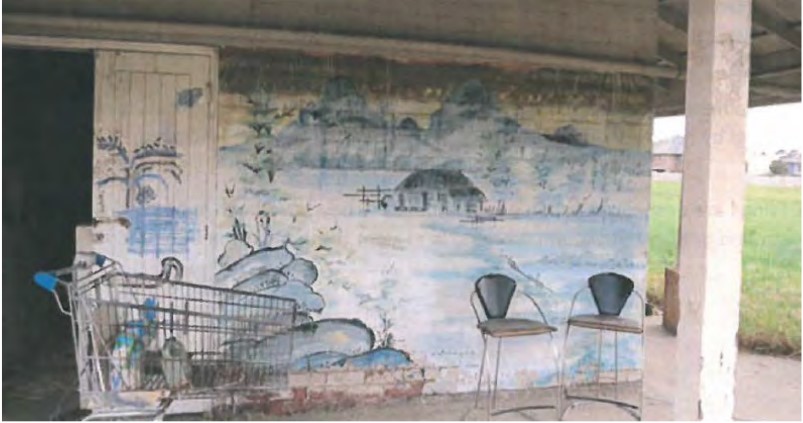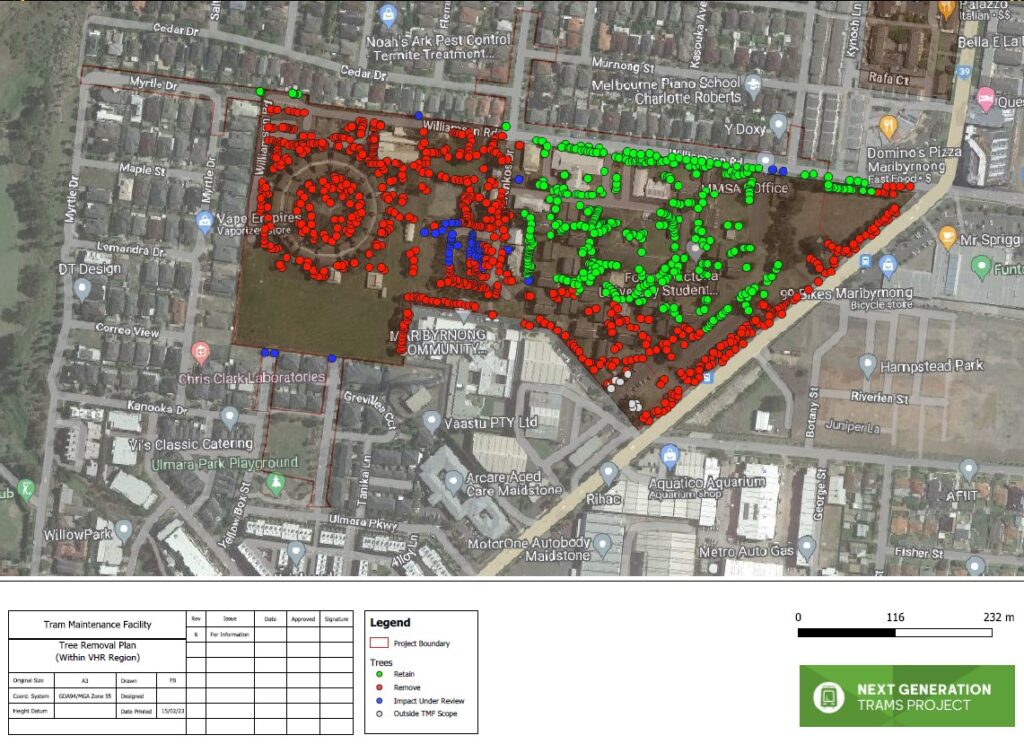Proposed demolition of Maribyrnong Former Migrant Hostel

Feature Image: Arrival at Maribyrnong former Migrant Hostel 1965, Source National Archives of Australia
The National Trust of Australia (Victoria) has objected to an application for significant development and demolition proposed at the Maribyrnong former Migrant Hostel, 61-71 Hampstead Road, Maidstone (VHR H2190). The permit application to Heritage Victoria for the proposed Tram Maintenance and Stabling Facility by the Department of Transport included the demolition of 22 buildings and 2 features of heritage value (as well as the relocation of another), and the removal of 720 out of 1154 trees in the Victorian Heritage Registered area. This would result in the complete demolition or relocation of the entire western half of the site as well as the trees and buildings on the southern and eastern extents.
Image: Proposed development includes Tram Maintenance and Stabling Facility, new internal road and widening of Hampstead Rd. Source: Department of Transport and Planning
The former Maribyrnong Migrant Hostel was included on the Victorian Heritage Register in 2009. The site’s Statement of Significance notes the following:
What is significant?
The former Maribyrnong Migrant Hostel has accommodated migrants from almost every national group that has arrived in Australia since World War II. Initially these were people from Britain and Europe but the later migrants arrived from Asia and South America and people escaping political upheavals in places such as Hungary, Chile and Vietnam….
Constructed of concrete metric modular bricks in 1971, the Phillip Centre consists of two concentric rings of two-storey accommodation buildings separated by an internal two-storey walkway… A landscaped garden was created inside the ring which was planted with native trees and shrubs. The accommodation units either looked out into this garden or out of the ring into the wider landscape…
Attempts by migrants to personalise their surrounding are apparent in a mural of windmills and tulips by Dutch migrants painted on the side of one of the surviving concrete bunker structures and a mural of an Asian scene that appears to have been painted by Vietnamese migrants on a section of wall of one of the ammunition stores located next to the Phillip Centre….
Why is it Significant?
The Former Maribyrnong Migrant Hostel is of historical significance for its associations with post World War II migration which contributed to the growth of Australia’s multi cultural society in the second half of the twentieth century. This is particularly apparent in the surviving murals which respectively represent European and Asian migration….The Former Maribyrnong Migrant Hostel site is of historical significance for its association with the New Pyrotechnic Section of the Explosives Factory Maribyrnong which played a vital part of the production armaments during World War II….The Former Maribyrnong Migrant Hostel is of historical significance as the largest and only intact surviving purpose built post World War II migrant hostel in Victoria…The Former Maribyrnong Migrant Hostel is of architectural significance as an extant example of buildings designed and built specifically as migrant accommodation…
Image: Vietnamese Mural at the former Migrant Hostel. Source: Lovell Chen CMP report, 2014
The National Trust objected to the permit application on the grounds that the large scale demolition and tree removal proposed had not been sufficiently justified and would have an unacceptable impact on the cultural heritage values of the site, as well as being against the sustainable commitments of the Department of Transport and Planning.
We believe that, due to the extent of demolition and tree removal required by the permit application, the proposed Tram Maintenance Facility is an inappropriate use of the site. Additionally, we found that the resulting interpretation would not be sufficiently legible within the public realm for the community to engage with.
In particular it is planned to demolish the Vietnamese mural and provide interpretation of the themes within the painting as part of the Tram Maintenance Facility. In our submission, the National Trust strongly encouraged the retention of the Vietnamese Mural either in situ or through relocation as the expert reports provided for this feature state that it is possible to retain and relocate the art piece and every effort should be made to do so.
Image: Proposed tree removal map for the former Migrant Hostel site. Source: Department of Transport, 2023
The National Trust further objected to the proposal to remove 62% of the trees across the heritage property. Of particular concern are the gardens and trees surrounding the Phillip Centre which were planted by migrants and former staff. Not only would the destruction of these trees severely impact the heritage values but it would reduce the urban tree canopy significantly. Increasing urban tree canopy is one of the strategies implemented across Victoria to mitigate impacts of Climate Change yet Maribyrnong has one the lowest urban tree canopy covers across metropolitan Melbourne. The Climate Change Act 2017 has an overarching goal to reduce emissions to net zero by 2050. The 720 trees proposed for removal are vital for carbon sequestering and reduce urban heat which is yet another reason they should be protected. The National Trust recommended that alternative designs should be investigated for the facility which would incorporate more of the existing trees in its infrastructure.
Read our full submission here.



I lived on Maribyrnong Hostel with my parents and brothers and sister, who was born during the time we lived there. We lived there for 18 months from 1965 to 1966 after emigrating from England as ‘ten pound poms’. My father worked for Australian Aircraft as an engineer and my mother worked as a registered nurse (SRN) at Footscray Hospital. As children we attended Maribyrnong State School. I have many memories, some good,some not so good, of this time but they are all part of Australia’s recent history: the building of a nation. We have photographs of the hostel from this time. We moved to buy a house in Doveton from the hostel and returned to England in 1970. My younger brother returned to live in Victoria 15 years ago.
As a 13-year-old Vietnamese refugee arriving in Australias in 1982, Midway Hostel was my first exposure to western lifestyle and foods. I remember skateboarding along Phillip corridors on its smooth concrete floor and attending the language centre just around the corner from there. Feeling nostalgic and a bit saddened after reading that those sites have been demolished for the new tram facility.
My parents and brothers arrived at the hostel in Dec 1987 as refugees, after fleeing from a civil war in El Salvador. Mum was pregnant at the time and I was born 3 months later in March. The hostel was my first home as a newborn. My parents and brothers have a lot of wonderful memories of the hostel, it was a whole new world for them.
Also accomodation for students at Footsray Insitute of Technolgy.
A reunion of 1974 members welcome